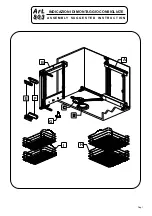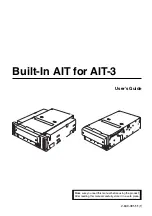
308
DS6000 Series: Concepts and Architecture
LVM configuration
In AIX all storage is managed by the
AIX Logical Volume Manager
(LVM). It virtualizes
physical disks to be able to dynamically create, delete, resize, and move logical volumes for
application use. To AIX our DS6000 logical volumes appear as physical SCSI disks. There
are some considerations to take into account when configuring LVM.
LVM striping
Striping is a technique for spreading the data in a logical volume across several physical disks
in such a way that all disks are used in parallel to access data on one logical volume. The
primary objective of striping is to increase the performance of a logical volume beyond that of
a single physical disk.
In the case of a DS6000, LVM striping can be used to distribute data across more than one
array (rank).
Refer to Chapter 11, “Performance considerations” on page 219 for a more detailed
discussion of methods to optimize performance.
LVM Mirroring
LVM has the capability to mirror logical volumes across several physical disks. This improves
availability, because in case a disk fails, there will be another disk with the same data. When
creating mirrored copies of logical volumes, make sure that the copies are indeed distributed
across separate disks.
With the introduction of SAN technology, LVM mirroring can even provide protection against a
site failure. Using long wave Fibre Channel connections, a mirror can be stretched up to a 10
km distance.
Another application for LVM mirroring is online (non-disruptive) data migration. See
Chapter 15, “Data migration in the open systems environment” on page 289.
AIX access methods for I/O
AIX provides several modes to access data in a file system. It may be important for
performance to choose the right access method.
Synchronous I/O
Synchronous I/O occurs while you wait. An application’s processing cannot continue until the
I/O operation is complete. This is a very secure and traditional way to handle data. It ensures
consistency at all times, but can be a major performance inhibitor. It also doesn’t allow the
operating system to take full advantage of functions of modern storage devices, such as
queueing, command reordering, and so on.
Asynchronous I/O
Asynchronous I/O operations run in the background and do not block user applications. This
improves performance, because I/O and application processing run simultaneously. Many
applications, such as databases and file servers, take advantage of the ability to overlap
processing and I/O. They have to take measures to ensure data consistency, though. You can
configure, remove, and change asynchronous I/O for each device using the
chdev
command
or SMIT.
Summary of Contents for System storage DS6000 Series
Page 2: ......
Page 5: ...iii...
Page 6: ...iv DS6000 Series Concepts and Architecture...
Page 18: ...xvi DS6000 Series Concepts and Architecture...
Page 24: ...xxii DS6000 Series Concepts and Architecture...
Page 26: ...2 DS6000 Series Concepts and Architecture...
Page 44: ...20 DS6000 Series Concepts and Architecture...
Page 46: ...22 DS6000 Series Concepts and Architecture...
Page 68: ...44 DS6000 Series Concepts and Architecture...
Page 88: ...64 DS6000 Series Concepts and Architecture...
Page 136: ...112 DS6000 Series Concepts and Architecture...
Page 138: ...114 DS6000 Series Concepts and Architecture...
Page 218: ...194 DS6000 Series Concepts and Architecture...
Page 242: ...218 DS6000 Series Concepts and Architecture...
Page 266: ...242 DS6000 Series Concepts and Architecture...
Page 298: ...274 DS6000 Series Concepts and Architecture...
Page 352: ...328 DS6000 Series Concepts and Architecture...
Page 392: ...368 DS6000 Series Concepts and Architecture...
Page 396: ...372 DS6000 Series Concepts and Architecture...
Page 404: ...DS6000 Series Concepts and Architecture DS6000 Series Concepts and Architecture...
Page 405: ......
















































